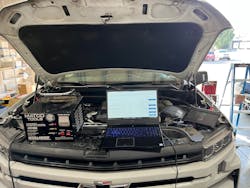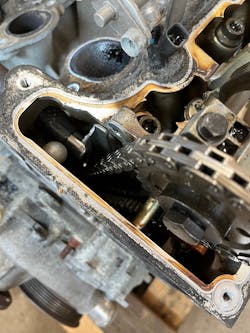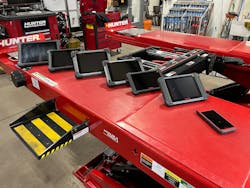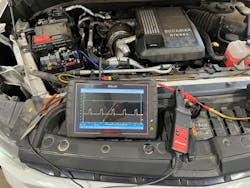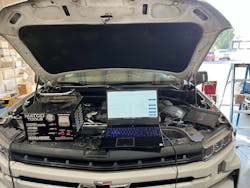The right tool for the engine job
The modern engine has become an increasingly more complicated system to diagnose and repair. When we begin looking at diesel engine emissions control systems and direct injection gasoline engines, it is a must we have the proper scanners and test equipment to properly test and repair these vehicles.
Even today’s sophisticated engine is still just a big air pump. The basics for an engine to run are air, fuel, compression, and spark. In the case of a diesel engine, the ignition is coming from compression. As the technician, it is your job to diagnose which of those requirements are the cause of the problem. Knowing which tool to use is key to a quick and successful diagnosis.
If you have a basic mechanical engine problem, such as a noise or a rattle in the engine, a technician's stethoscope from Snap-on or Matco's Wireless ChassisEars are a great way to help pinpoint the noise (Figure 1).
There are several engines out there today that have issues with the valvetrain. In many cases, you will have to resort to opening up the engine to see the specific damage (Figure 2).
In this picture, we can see a broken timing chain guide on a Ford 4.0L engine. The customer’s original concern was a loud rattling noise from the engine. We used a stethoscope to find where the noise was loudest and took off that valve cover. Once inside the engine, it was easy to see the cause of the customer’s concern. Due to the overall condition of the engine, and the amount of metal from the guide circulating through the engine, we decided to install a used engine at the customer’s request to correct the issue.
Next, we need to determine if it is air, fuel, or compression. As simple a tool as a vacuum gauge is, it is a great way to determine if you should proceed further with a compression test or leak down tester. In Figure 3, we have a Matco Tools diesel compression tester on the left, a Snap-on gasoline engine compression tester in the middle, and a Star Products cylinder leakage tester on the right.
Before testing for proper air supply to the engine, it should be started with a simple visual inspection of the air filter. I have seen some air filter boxes entirely full of dog food or acorns. Those rodents can be pesky creatures when getting ready for winter. The interesting part is that those vehicles were driven on a regular basis (Don’t assume — always perform that visual inspection).
Next, perform your engine vacuum test with a Mac Tools VG3000 vacuum gauge and check it against your specs for the vehicle. You will be able to determine if it is time to perform a compression test and possibly a cylinder leakage test with a Matco Tools CLT2APB to determine if it is an intake valve, exhaust valve, or a piston sealing problem. All of these tools are relatively inexpensive but mandatory for determining the basic mechanical integrity of the engine.
When diagnosing fuel systems, the age of the vehicle will be a major player in which tool that you are going to be using. On old carbureted cars, you will be using your vacuum/pressure gauge and looking for approximately 4 to 6 psi. If you recall fuel-injected cars from the '80s, you were looking for 35 to 60 psi. For today’s cars, you are going to be using a scanner to verify high pressure fuel system pressures on both gasoline and diesel engine vehicles.
We do quite a bit of diagnostic and ADAS work at our shop, so as you can see from Figure 4, we have several Autel scan tools. We also have a Snap-on Zeus, Snap-on Vantage Legend, and a Thinkcar Platinum S20. The majority of these tools are used on a daily basis, allowing us to work on present model year vehicles.
Always refer to your information system to determine the proper fuel system test procedure and specification. Be careful, on your any of your vehicles with direct injection, the high-pressure fuel systems can cause severe personal injury. Follow the specific repair procedures for the vehicle you are working on.
When it comes to testing ignition systems, I will always start with a code scan to see if I can determine the specific cylinder. The diagnostic systems on the vehicles these days are very good at pinpointing a cylinder in question, but not what is actual causing the specific problem. That’s our job. I will grab my oscilloscope to look at the current ramping of the coil packs.
The best part of individual coil packs is that you have several other examples of “known good examples”. There are plenty of tools on the market that are pinpoint based testing on ignition coils, like the Blue Point YA76562, and cost much less than an oscilloscope. In many cases you can even use a Fluke 88 automotive DVOM to test coil resistances and available voltage. Always check your service information for wiring diagrams when performing pinpoint testing on the ignition systems.
When we begin any diagnosis at my shop, we always start with duplicating the customer’s concern. If you cannot duplicate the concern, how are you supposed to find it? Once we have duplicated the concern, we will typically scan all the computers in the vehicle for trouble codes. Now that we have collected that data, we will go to Identifix (Figure 5) to look for TSBs, recalls, and common failures. We will use that as guidance when we begin testing the vehicle to confirm the concern.
We recently had a 2020 Chevrolet Silverado with the new 3.0L Duramax Diesel. The customer’s concern was the vehicle entering limp home mode with a service wrench light and check engine light. If the customer cycled the key, the service wrench light would reset. The vehicle had been to the dealer at least once for this concern but was unable to duplicate the concern. We were able to duplicate the customers concern but not on a repeatable basis. We grabbed our Autel Ultra scanner for the job since it will also provide a network Topology map when performing a full vehicle scan (Figure 6). We did find the vehicle to have three trouble codes related to the problem:
- P0202:00 Cylinder 2 injector control circuit
- P0216:00 Injection timing control circuit
- P0300:00 Random or multiple cylinder misfire
When checking the vehicle service information from Mitchell, we checked TSBs and found an applicable TSB for the engine wire harness having chaffing issues throughout the engine compartment. Our next step was to remove the left front inner fender liner to access the PCM and to gain access to the wire harness. The bulletin was very good at listing the rub points that were common, making our job easier.
We hooked up our Snap-on Zeus oscilloscope with the Snap-on low amp clamp and also a fuse tap from AES Wave to the ECM fuse that provides power to the injectors (Figure 7).
Our goal was to monitor the voltage and current ramping of the injectors while performing a wiggle test on the harness. One technician performed the wiggle test while another technician focused on the oscilloscope. No problems were found during this test. We let the vehicle hot soak after a long road test and the problem occurred as soon as we restarted the vehicle.
As we continued the diagnosis, we could confirm the hot soak would trigger the problem every time (perfect, a bad PCM it is!). We replaced the PCM and reflashed it with the Autel Ultra’s MaxiFlash VCMI and GM’s Service Programing System. We did use a Matco MC9440 Battery maintainer for our power supply for the vehicle’s stable voltage (Figure 8).
A quick side note, that battery maintainer is getting on the older side and can only handle 50A. It is recommended that a 100A battery maintainer be used for today’s cars, so we will be upgrading very soon. Vehicle was extensively road tested and verified to be fixed!
Remember, our time is money so understanding the systems you are working on is critical to making an accurate and fast diagnosis. Know your tools and how to use them efficiently. Sometimes, this will require training and simply working with the tool, so that when it comes time, you can effectively use it to locate the problem.
I recently attended an oscilloscope class, and I was surprised at the number of lead sets and even screen protectors that were in the audience. It was clear that many of the oscilloscopes were being used for the first time. It will be very challenging for a technician to find a problem with a vehicle if they aren’t comfortable with their tool of choice.
